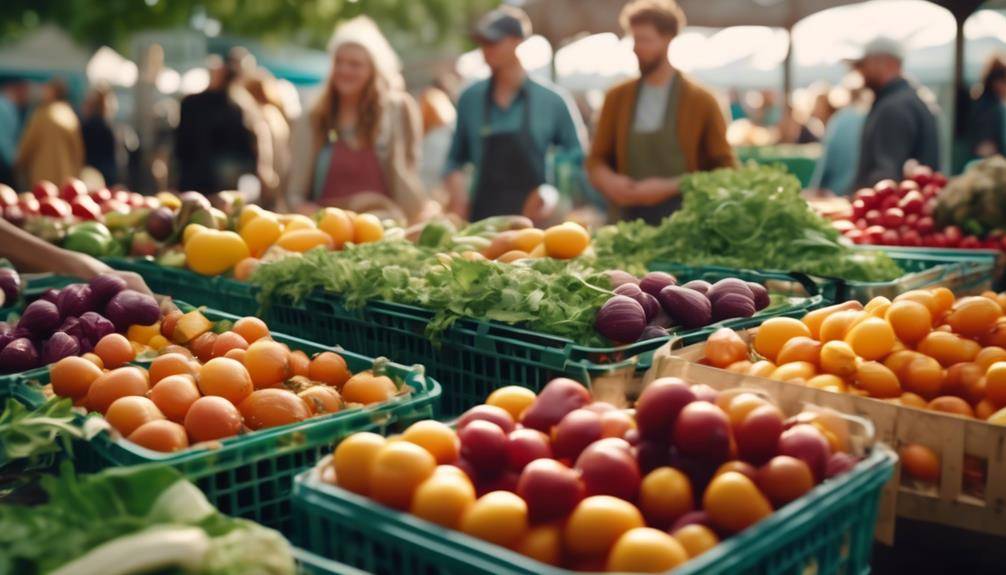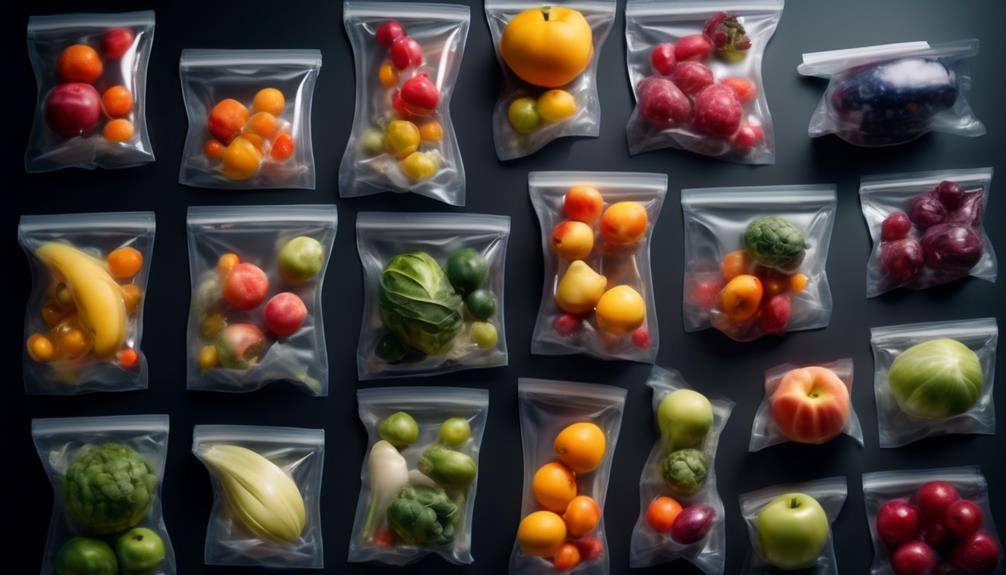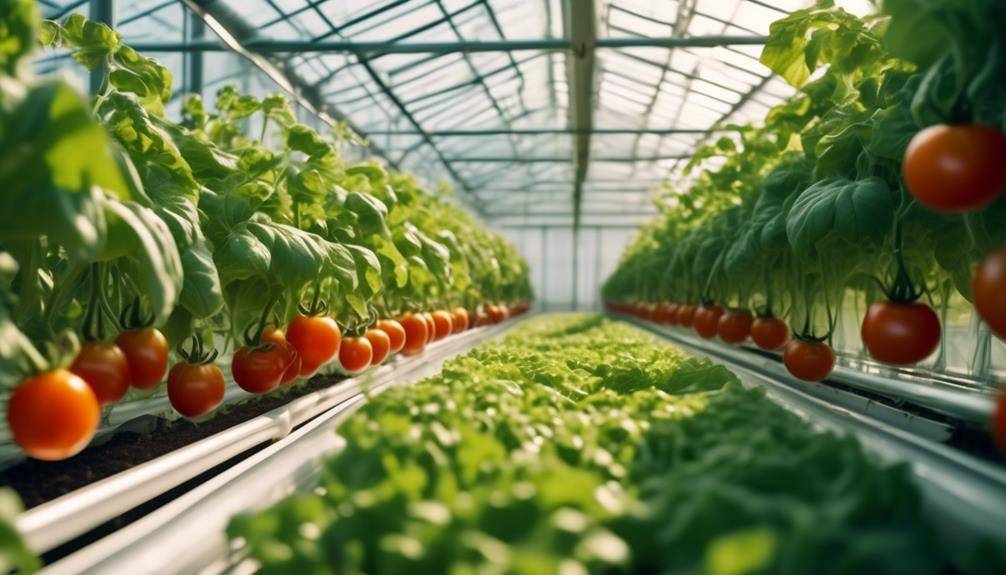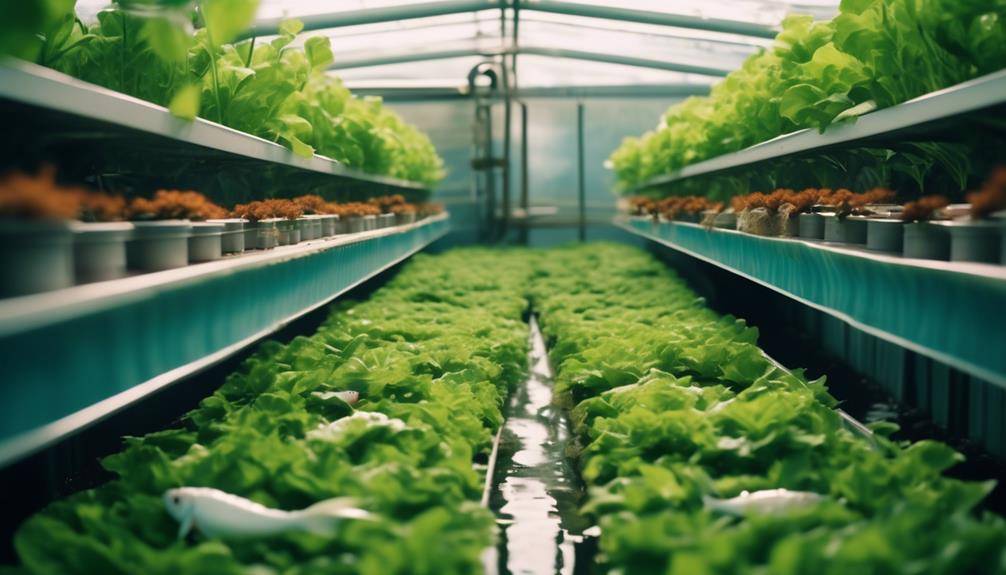Exciting Popular Food Waste Reduction Trends

Are you skeptical about the possibility of significant Food Waste Reduction Trends in the year 2024? Well, prepare to be pleasantly surprised. The latest trends and advancements in the field indicate that we are on the cusp of a transformative era in food waste management. From innovative technologies to collaborative initiatives, the future looks promising for tackling this global issue. In this discussion, we will explore some of the most exciting developments in food waste reduction, leaving you eager to discover the strategies that will shape the landscape of sustainable food practices in the coming years.
Technological Advancements in Food Waste Reduction
Technological advancements have revolutionized the way we approach food waste reduction, enabling us to tackle this global issue more efficiently and effectively. The integration of smart sensors and waste analytics has played a crucial role in transforming our approach to managing and reducing food waste.
Smart sensors are being widely utilized to monitor various aspects of the food supply chain, from production to consumption. These sensors are capable of tracking temperature, humidity, and other environmental conditions, ensuring the optimal preservation of perishable goods. By continuously monitoring these factors, smart sensors can detect any deviations or anomalies that may lead to spoilage or waste. This real-time data allows for timely intervention and mitigation, minimizing the chances of food loss.
Furthermore, waste analytics has emerged as a powerful tool in identifying patterns and trends in food waste generation. By analyzing data collected from various sources, such as point of sale systems, inventory management software, and consumer behavior, waste analytics can provide valuable insights into the factors contributing to food waste. This data-driven approach enables businesses and organizations to make informed decisions and implement targeted strategies to reduce waste at different stages of the supply chain.
The combination of smart sensors and waste analytics has the potential to revolutionize our approach to food waste reduction. By leveraging real-time data and insights, we can identify inefficiencies, optimize processes, and ultimately minimize food waste. This not only has environmental benefits but also economic advantages, as reducing food waste can lead to significant cost savings for businesses. As technology continues to advance, we can expect further innovations in this field, paving the way for a more sustainable and efficient food system.
Increased Adoption of Smart Packaging Solutions
Smart packaging solutions are increasingly being adopted as a means to reduce food waste in the supply chain. With the integration of technology, smart packaging offers numerous benefits that contribute to minimizing food waste throughout the entire food production and distribution process.
One of the key advantages of smart packaging is its ability to extend the shelf life of perishable goods. By monitoring and controlling temperature, humidity, and oxygen levels within the packaging, smart packaging helps maintain optimal conditions for food preservation. This reduces the risk of spoilage and extends the product’s lifespan, thereby reducing the amount of food wasted due to premature expiration.
In addition, smart packaging enables real-time tracking and monitoring of products throughout the supply chain. By incorporating sensors and RFID technology, it becomes possible to monitor factors such as temperature, location, and handling conditions. This data allows for better inventory management, early detection of potential issues, and improved quality control. By identifying and addressing potential problems promptly, smart packaging helps prevent food waste before it occurs.
Furthermore, smart packaging provides consumers with valuable information about the freshness and quality of the product. Innovative packaging solutions, such as time-temperature indicators, can visually indicate whether the product has been exposed to unfavorable conditions during transportation or storage. This empowers consumers to make informed decisions about the safety and suitability of the food they purchase, reducing the likelihood of food waste resulting from uncertainty or mistrust.
As technology continues to advance, smart packaging solutions will undoubtedly play a crucial role in the ongoing efforts to reduce food waste. By integrating technology into packaging materials, we can enhance food safety, extend shelf life, and improve supply chain efficiency. Embracing these innovative solutions will not only benefit businesses but also contribute to a more sustainable and resource-efficient future.
Implementation of Blockchain Technology in Supply Chain Management
With advancements in technology and the increasing need for enhanced supply chain management, the implementation of blockchain technology is revolutionizing the way food waste is addressed and reduced. By leveraging blockchain applications in traceability, the food industry is able to achieve greater transparency in supply chain management, ensuring that every step of the process is recorded and easily accessible. This not only helps to prevent food waste but also improves overall efficiency and consumer trust.
Here are two key ways in which blockchain technology is transforming supply chain management:
- Enhanced Traceability:
- Blockchain enables the creation of an immutable and decentralized ledger, allowing for the transparent tracking of food products from farm to fork. Every transaction, such as harvesting, processing, and transportation, is recorded on the blockchain, ensuring that the origin and journey of each item can be easily traced.
- With this increased traceability, it becomes easier to identify and address inefficiencies or potential points of food waste. For example, if a batch of produce is found to be contaminated, blockchain technology can quickly identify the source and help recall affected products, minimizing the spread of contamination and reducing food waste.
- Improved Trust and Collaboration:
- Blockchain provides a platform for all stakeholders in the supply chain, including farmers, manufacturers, distributors, retailers, and consumers, to securely share and access information. This fosters a collaborative environment where all parties can contribute to reducing food waste.
- Through blockchain, consumers can verify the authenticity and quality of the products they purchase, ensuring that they are making informed choices. This not only reduces the risk of food waste at the consumer level but also promotes sustainable practices throughout the supply chain.
Growing Popularity of Food Sharing Platforms
Food sharing platforms are gaining widespread popularity as a sustainable solution to reduce food waste and promote community collaboration. These platforms, which are designed to facilitate the redistribution of surplus food, have seen a significant increase in adoption in recent years. By connecting food donors with recipients in need, these initiatives are tackling the issue of food waste head-on while also fostering community engagement.
One of the reasons behind the growing popularity of food sharing platforms is their ability to address the inefficiencies in our food system. According to the Food and Agriculture Organization (FAO), approximately one-third of all food produced globally is wasted. This not only leads to economic losses but also has a significant environmental impact. By utilizing food sharing platforms, surplus food that would otherwise go to waste can be redirected to those who need it, reducing both food waste and hunger.
Food sharing platforms also provide an opportunity for community engagement. These platforms often rely on volunteers who help collect and distribute surplus food to local organizations or individuals. This collaborative effort fosters a sense of community and solidarity, as individuals come together to address a pressing social issue.
Furthermore, food sharing platforms can have a positive economic impact. By diverting surplus food from waste streams, businesses can save on disposal costs. Additionally, individuals and organizations who receive donated food can reduce their expenses on groceries, allowing them to allocate their resources to other essential needs.
Expansion of Composting and Anaerobic Digestion Practices
You might be interested to learn that the expansion of composting and anaerobic digestion practices brings numerous benefits to the environment. Composting allows for the organic matter to break down naturally, reducing the release of greenhouse gases and enriching the soil with nutrients. On the other hand, anaerobic digestion not only reduces waste but also generates biogas that can be used as a renewable energy source. The expansion of these practices improves waste management systems and contributes to a more sustainable future.
Composting Benefits the Environment
The expansion of composting and anaerobic digestion practices presents numerous environmental benefits, reducing food waste and contributing to a more sustainable future. Here are some key reasons why composting benefits the environment:
- Reduction of methane emissions:
- Composting organic waste prevents it from decomposing in landfills, where it would produce methane, a potent greenhouse gas.
- By diverting food waste to composting facilities or home compost bins, methane emissions can be significantly reduced.
- Soil enrichment:
- Compost acts as a natural fertilizer, improving soil health and structure.
- It enhances water retention, reduces erosion, and promotes healthier plant growth without the need for synthetic chemicals.
Composting offers a simple yet effective solution to tackle food waste while simultaneously addressing climate change and promoting sustainable agriculture. By embracing composting practices on a larger scale, we can create a more environmentally friendly and resilient future.
Anaerobic Digestion Reduces Waste
Anaerobic digestion, a process that breaks down organic waste in the absence of oxygen, offers a promising solution for reducing waste and maximizing resource recovery. This technology converts food waste, agricultural residues, and other organic materials into biogas and nutrient-rich digestate. The benefits of anaerobic digestion are significant. Firstly, it reduces greenhouse gas emissions by capturing methane, a potent greenhouse gas, and converting it into biogas.
Secondly, it diverts organic waste from landfills, reducing the production of methane, which is a major contributor to climate change. Furthermore, anaerobic digestion produces a valuable renewable energy source in the form of biogas, which can be used for heat, electricity, or transportation fuel. With its ability to efficiently process organic waste and generate renewable energy, anaerobic digestion holds immense potential for the future of waste management and sustainable energy production.
Expansion Improves Waste Management
Expanding composting and anaerobic digestion practices is a key step towards improving waste management and maximizing resource recovery. By increasing the adoption of these practices, several benefits can be achieved:
- Reduction of organic waste sent to landfills: Expanding composting and anaerobic digestion practices allows for the diversion of a significant portion of organic waste from landfills. This not only reduces the environmental impact of waste disposal but also prevents the release of harmful greenhouse gases.
- Generation of valuable byproducts: Composting and anaerobic digestion processes produce nutrient-rich compost and biogas, respectively. These byproducts can be utilized in agriculture, energy production, and other industries, contributing to a more sustainable and circular economy.
Rise of Regenerative Agriculture for Waste Reduction
Regenerative agriculture is rapidly gaining momentum as a transformative solution for reducing food waste. With its focus on sustainable farming practices, regenerative agriculture offers innovative waste reduction strategies that can have a significant impact on the food industry.
One key aspect of regenerative agriculture is its emphasis on soil health. By implementing regenerative agriculture practices such as cover cropping, crop rotation, and composting, farmers can improve soil health and fertility. Healthy soils lead to increased crop yields and reduced dependence on chemical fertilizers and pesticides. This, in turn, reduces the amount of wasted produce that results from poor soil quality or pest infestations.
Additionally, regenerative agriculture promotes biodiversity on farms. By diversifying crops and incorporating natural habitats, farmers can create ecosystems that support a wide range of beneficial organisms. These organisms, such as pollinators and natural predators, help control pests and diseases, reducing the need for chemical interventions. This approach not only reduces food waste resulting from damaged or contaminated crops but also contributes to the overall sustainability and resilience of the farm ecosystem.
Furthermore, regenerative agriculture encourages the use of on-farm waste for energy production and nutrient cycling. By utilizing technologies such as anaerobic digesters and composting systems, farmers can convert agricultural byproducts into renewable energy sources and nutrient-rich compost. This closed-loop system minimizes waste generation and maximizes resource efficiency.
Emphasis on Reducing Food Waste at the Consumer Level
You have the power to make a significant impact on reducing food waste as a consumer. By being mindful of your purchasing habits and consumption patterns, you can help minimize the amount of food that goes to waste. Educational campaigns have shown success in raising awareness and providing practical tips on how to reduce food waste at home. Let’s explore the ways in which consumer behavior can make a difference and how successful initiatives can inspire further change.
Consumer Behavior Impact
Consumers play a crucial role in reducing food waste at the individual level by implementing conscious consumption habits and adopting sustainable practices. Consumer awareness and behavioral change are key factors in addressing the issue of food waste. Here are two ways in which consumer behavior can have a significant impact:
- Meal planning and portion control: By planning meals in advance and being mindful of portion sizes, consumers can reduce the amount of food that goes to waste. This involves buying only what is needed, storing food properly, and using leftovers effectively.
- Understanding expiration dates: Consumers often misunderstand expiration dates, leading to unnecessary food waste. By educating themselves about different types of expiration dates and understanding the difference between “best before” and “use by” dates, consumers can make more informed decisions about when to consume or discard food.
Educational Campaign Success
The success of educational campaigns focusing on reducing food waste at the consumer level can be attributed to increased awareness and adoption of sustainable practices. These campaigns have proven to be highly effective in influencing consumer behavior and promoting positive change. By providing consumers with information about the environmental and economic impacts of food waste, educational campaigns have successfully raised awareness about the issue. This increased awareness has led to a shift in consumer behavior, with more individuals actively seeking ways to reduce their food waste.
Moreover, educational campaigns have also provided consumers with practical tips and strategies to minimize waste in their daily lives. As a result, consumers are now more conscious of their food consumption habits and are making conscious choices to prevent food waste.
Implementation of Food Waste Tracking Systems
Implementing food waste tracking systems is crucial for reducing food waste and improving sustainability in the food industry. These tracking systems offer several benefits that aid in the fight against food waste:
- Real-time monitoring: Tracking systems provide real-time data on food consumption, allowing businesses to identify areas of waste and take immediate action. This enables better decision-making and adjustments to production and inventory management.
- Efficient resource allocation: By accurately tracking and analyzing food waste, businesses can determine where resources are being wasted and optimize their usage. This helps reduce costs associated with overproduction, excess inventory, and energy consumption.
- Improved sustainability practices: Food waste tracking systems promote sustainable practices by encouraging businesses to minimize waste throughout the supply chain. This includes reducing overstocking, optimizing storage conditions, and implementing better inventory management techniques.
- Consumer engagement: Implementing food waste tracking systems can also help businesses engage with consumers and raise awareness about the importance of reducing food waste. By sharing data on waste reduction efforts and involving customers in the process, businesses can foster a sense of responsibility and encourage more sustainable consumption habits.
- Reduced environmental impact: Food waste contributes significantly to greenhouse gas emissions, deforestation, and water scarcity. By implementing tracking systems, businesses can significantly reduce their environmental footprint by minimizing waste and making more sustainable choices.
- Financial savings: Reducing food waste through tracking systems can lead to significant cost savings for businesses. By optimizing inventory management, reducing overproduction, and minimizing food waste, businesses can decrease expenses and improve profitability.
Implementing food waste tracking systems is a proactive step towards a more sustainable and efficient food industry. By harnessing the power of data, businesses can make informed decisions, reduce waste, and contribute to a healthier planet.
Promotion of Sustainable Food Production Methods
To promote sustainable food production methods, businesses can adopt innovative techniques that prioritize environmental conservation and resource efficiency. Implementing sustainable farming techniques is crucial in reducing the environmental impact of food production. These techniques include practices such as organic farming, agroforestry, and precision agriculture.
Organic farming eliminates the use of synthetic fertilizers, pesticides, and genetically modified organisms (GMOs). By relying on natural methods like crop rotation, composting, and biological pest control, organic farming minimizes soil erosion, protects biodiversity, and reduces water pollution. It also contributes to healthier soil, which results in more nutrient-rich and flavorful crops.
Another sustainable farming technique is agroforestry, which involves integrating trees and crops in the same farming system. This method provides multiple benefits. Trees help prevent soil erosion, provide shade, and create habitats for beneficial insects and birds. They also contribute to carbon sequestration, helping to mitigate climate change. Agroforestry systems can increase crop productivity while reducing the need for synthetic inputs.
Precision agriculture utilizes technology to optimize the use of resources. By employing sensors, drones, and GPS, farmers can monitor the specific needs of their crops and apply inputs such as water, fertilizers, and pesticides more efficiently. This precision reduces waste and minimizes environmental impact.
In addition to sustainable farming techniques, businesses should prioritize organic waste management. Composting food waste and using it as fertilizer can close the nutrient loop, reducing the need for synthetic fertilizers. Companies can also explore innovative solutions like anaerobic digestion, which converts organic waste into biogas and organic fertilizers.
Collaboration Between Food Industry Stakeholders
Collaboration among food industry stakeholders is crucial for driving meaningful change and achieving significant reductions in food waste. By working together, stakeholders can leverage their unique expertise and resources to implement effective food waste prevention initiatives. Here are two ways cross-sector collaboration can contribute to the fight against food waste:
- Sharing Best Practices: Collaborative efforts allow food industry stakeholders to share their knowledge and experiences in tackling food waste. By exchanging best practices, stakeholders can learn from one another and adopt proven strategies that have been successful in reducing waste. This knowledge sharing can be facilitated through conferences, workshops, and online platforms, providing a space for stakeholders to come together and collectively address the issue.
- Supply Chain Optimization: Collaboration across the food supply chain is essential for reducing waste at every stage, from production to consumption. By working together, stakeholders can identify areas of inefficiency and implement measures to optimize the supply chain. This may involve improving transportation and logistics, implementing better inventory management systems, or developing innovative packaging solutions. By streamlining operations and reducing inefficiencies, stakeholders can minimize food waste and ensure that more food reaches consumers instead of being discarded.
Through cross-sector collaboration, food industry stakeholders can pool their resources, knowledge, and expertise to drive sustainable change and make significant progress in reducing food waste. By sharing best practices and optimizing the supply chain, stakeholders can work towards a future where food waste is minimized, resources are utilized efficiently, and more people have access to nutritious food. The collective efforts of the food industry can pave the way for a more sustainable and food-secure future.
Integration of Artificial Intelligence in Food Waste Management Systems
Artificial intelligence is revolutionizing food waste management systems, enabling more efficient and accurate monitoring and prevention of waste. With AI-powered waste reduction technology, smart waste management systems are becoming increasingly sophisticated in identifying and addressing food waste at every step of the supply chain.
AI algorithms can analyze vast amounts of data in real-time to identify patterns and predict potential waste scenarios. By integrating AI into food waste management systems, companies can optimize inventory management, reduce overproduction, and minimize the risk of food spoilage. This not only saves money but also reduces the environmental impact of wasted resources.
One example of AI-powered waste reduction is the use of computer vision technology to monitor food quality and freshness. Cameras equipped with AI algorithms can visually inspect food items and alert operators if any signs of spoilage or contamination are detected. This allows for immediate action to be taken, preventing the sale or distribution of unsuitable products and reducing waste.
AI can also enhance the efficiency of food donation programs. By analyzing data on demand and supply, AI algorithms can identify potential food surplus and connect it with organizations or individuals in need. This streamlines the process of food redistribution, ensuring that edible food is diverted to those who can benefit from it instead of being discarded.
Furthermore, AI-powered predictive analytics can help optimize production and distribution processes. By analyzing historical data on sales, weather patterns, and consumer behavior, AI algorithms can provide valuable insights to optimize inventory levels, production schedules, and transportation routes. This reduces the likelihood of excess inventory and ensures that food reaches its destination in a timely manner, minimizing waste along the way.
Food Waste Reduction Trends; Frequently Asked Questions
How Can Regenerative Agriculture Contribute to Waste Reduction in the Food Industry?
Regenerative agriculture can contribute to waste reduction in the food industry by improving soil health, minimizing chemical inputs, and promoting biodiversity. By implementing sustainable practices, you can help create a more efficient and eco-friendly food system.
What Are Some Examples of Sustainable Food Production Methods Being Promoted?
Vertical farming and organic farming are examples of sustainable food production methods being promoted. They utilize innovative techniques to maximize yield and minimize environmental impact. These methods contribute to a more efficient and sustainable food system.
How Does the Integration of Artificial Intelligence Help in Managing Food Waste?
AI powered food waste management integrates artificial intelligence to implement efficient waste reduction strategies. By analyzing data and patterns, AI systems can optimize inventory management, track expiration dates, and suggest sustainable consumption habits, leading to significant reductions in food waste.
Can You Provide Examples of Food Waste Tracking Systems Being Implemented?
Food waste tracking systems are being implemented in various industries. These initiatives help businesses monitor and reduce food waste by providing real-time data and insights. By leveraging technology, they contribute to the overall goal of reducing food waste.
How Does the Implementation of Blockchain Technology Improve Supply Chain Management in Relation to Food Waste Reduction?
Blockchain applications improve supply chain management by providing transparent and immutable records of food products. With traceability solutions, you can easily track the journey of food from farm to table, reducing food waste and ensuring food safety.
Conclusion
In conclusion, the future of food waste reduction looks promising with advancements in technology, smart packaging solutions, and blockchain technology. The popularity of food sharing platforms and the expansion of composting and anaerobic digestion practices will further contribute to reducing waste. Implementation of food waste tracking systems, promotion of sustainable food production methods, collaboration among industry stakeholders, and integration of artificial intelligence will play vital roles in achieving efficient and effective food waste management in the coming years.








